In the last part of a series about traveling in Vietnam’s northwestern region, Tuan Anh explores a place whose name was once synonymous with “Nowhere Land.”
Northwest series
>> Part 1: No amount of fog
can stop this view
>> Part 2: Driving through Heaven's
Gate
>> Part 3: Riding the rails back
home
>> Part 4: A foggy
endeavour
>> Part 5: No plans in "Nowhere Land"
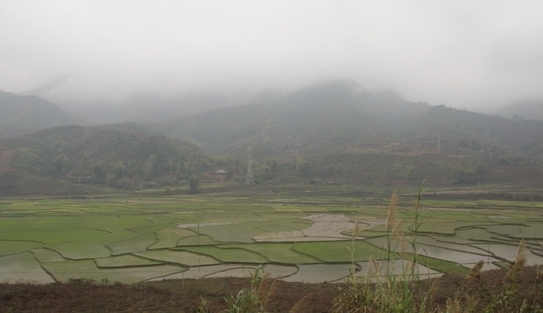
On the way out of Than Uyen Town.
We didn’t really plan ahead much for our trip, thus we were taken by many pleasant surprises, one of which was the marvelous drive through Mu Cang Chai, Yen Bai Province.
For me personally, the phrase “life is a journey, not a destination” has always rung true, although the destinations have also played an important role by their own means. However, for all of us who embarked on this northwestern adventure, the old phrase has been given a new meaning.
After Sin Ho, it had become clear to us that most major destinations during our trip, at least during Tet, would have much less to offer than the journey to get there itself. Although we had not had the chance to observe a great deal of the much-talked-about views of the region due to the fog, the drives through a constant cloud had been a unique and remarkable experience in their own right.
Traveling during Tet in the northwestern region had not proven to be ideal in terms of scenery, but it did offer a rare chance to be secluded on the roads. Only once or twice a year can such a few amount of vehicles be found on the roads. Another advantage of roaming the mountainous areas during winter is that we always had cold drinks in our car without needing to worry about ice.
Our lack of views were generously compensated for on the last day of our trip. We had spent the previous night in Than Uyen, a town on the outskirts of Lai Chau Province which is the hub of the northwestern region where roads converge and spread out in many various directions. To get to Hanoi from there, we would drive for about 230 kilometres and past the famous Mu Cang Chai District in the neighbouring province of Yen Bai.
Mu Cang Chai is famous for two reasons: First, the name was synonymous with “Nowhere land” in Vietnamese for a long time. Many people did not even know that the place actually existed and thought it was just an expression for any extremely remote and hard-to-find place. The second reason is for it's beautiful terraced fields. Many consider them to be among the most amazing in Vietnam, if not the world.
We left Than Uyen early in the morning and were glad to see that the weather had become warmer and the fog had disappeared. The road out of Than Uyen was peaceful and didn't have the curves which I had been dealing with for so long. This was a relief and I was happy to accelerate the car to 80 km/h for the first time during the whole trip.
Before long, we started to enter another mountain pass, but this one was not too tough, especially after we had handled the notoriously treacherous mountain passes of O Quy Ho, Ma Thi Ho, Giang Ma and Chan Nua, all just a few days earlier.
Little did we know that we were driving on the Vach Kim Pass, and it was just a small taste of what would come on the great Khau Pha Pass, one of the most perilous mountain passes in the northwestern region.
On the way from Vach Kim to Khau Pha, the surrounding views were a splendid green with an abundance of pine trees covering the mountains and tiny waterfalls scattered around everywhere. Traditional wooden houses of ethnic people occasionally showed up in the picture, giving it a wonderful homey touch.
We admittedly did not do thorough research on the way around the region beforehand, but just got into the car and went. As we got out of the Vach Kim Pass and onto Khau Pha Pass, all we came to know is that name on a road sign. Only after getting home did we find out that Khau Pha is known as one of the most curvy, steep and lengthy mountain passes in Vietnam, ranging over 30 kilometres, with an average height of 1,200 to 1,500 metres above sea level.
Nonetheless, the drive was much easier than the previous days as there was virtually no fog. I had now gotten quite comfortable with driving around mountains, so Khau Pha was all but a magnificent drive for me, as my vision was not blocked by the fog anymore. As we climbed up the road, majestic sights of the valley below started to appear bit by bit, and although most of those famous terraced fields hadn’t put on their typical green and yellow colours of cropping season, the view was still remarkable.
Meanwhile, the outside temperature kept dropping to 8, 6, 4, 3, and then 1 degrees Celsius when we realised that we were on the absolute top of the pass. We were so excited to get out of the car and breathe in the cold, fresh air with a near-freezing temperature, the coldest we had ever experienced in Vietnam.
After that, we started descending the mountain and getting closer to the fields. We now realised that the mountain pass served as a perfect means for travelers to observe the beautiful terraced fields from up-high and then up-close.
The sight of the fields would soon be replaced by the centre town of Mu Cang Chai. The town no longer fits into the legends it was once famous for. First, it is no longer a remote and critically underdeveloped place like it was decades ago, it looks like any typical town in rural Vietnam these days. Second, there is not much to see within the town itself; the attractiveness of the name Mu Cang Chai for travelers now lies on its terraced fields outside of the town.
We drove past Mu Cang Chai town, towards Nghia Lo, another major town in Yen Bai Province, where we would have lunch. This drive was also exciting as it took us through another mountain pass called Chau, and yet more breathtaking views of rice fields, mountains and trees.
At Nghia Lo, we stopped by a restaurant in a wooden house on stilts built in the style of the traditional Muong ethnic people. We were lucky that this was a rare restaurant that opened so early after Tet, although the only dish they offered was hot-pot. It was no problem for me and another friend, as we instantly ordered a chicken hot pot, but it got caused two of my hungry friends, who happened to be vegetarians, to wondering what they would eat. We soon decided to order another hot-pot with only clear water, and my friends happily put in some seasoning, vegetables and tofu, enjoying their first-ever vegetarian hot-pot.
From Nghia Lo back to Hanoi, the drive was smooth and fast. There were no more mountains, although the traffic got just a little bit heavier than before. The landscape changed dramatically as we drove out of Yen Bai Province into Phu Tho Province. We no longer saw the mountainous ethnic Dao, H’Mong and Thai groups, but started to see the Muong people and their typical houses on stilts, and then the Vietnamese majority’s villages. In Phu Tho Province, tea farms on hills offered a different but no-less attractive sight than the terraced rice fields of Yen Bai Province.
We got home to Hanoi at about 8pm, exhausted from the long trip, but satisfied that we made it and got to see the unique sceneries of northwestern Vietnam. Traveling there
during Tet might not be ideal due to the fog and the fact that the terraced fields are not at the top of their game, but we have come to decide to revisit in the summer, without
a doubt.
|
Surfing the net on the go: This was a chance for me to test mobile Internet usage throughout the northwestern area. I brought along two USB modems, one was 3G Viettel and the other was 2.5G MobiFone. In most major towns, except Sin Ho, I could use either or both of them to get on the web with reasonable speed and stable connection. Sometimes I even managed to use them on the road, but the connection was on and off depending on whether we were driving in a covered area or not. |
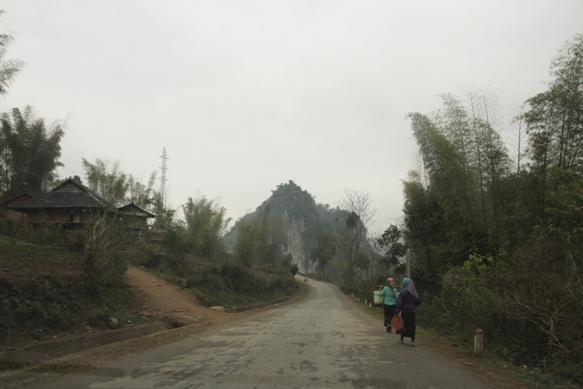
H'Mong people walking on the road.
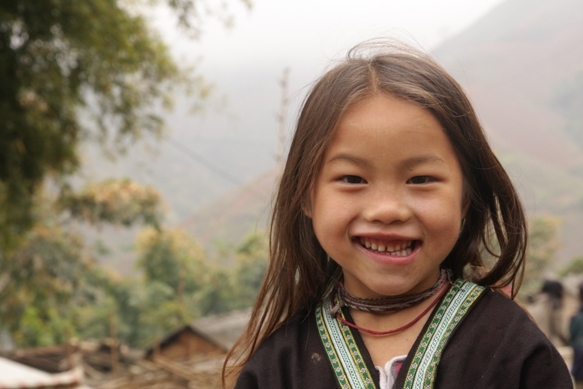
A smile on a H'Mong girl.
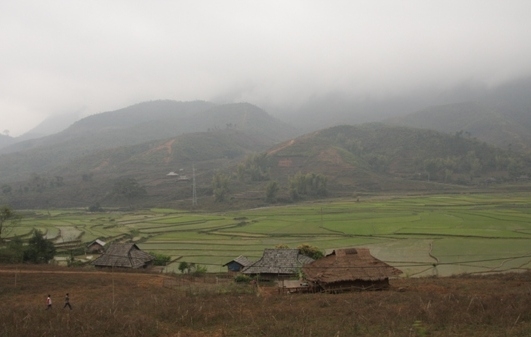
Houses by the rice fields.
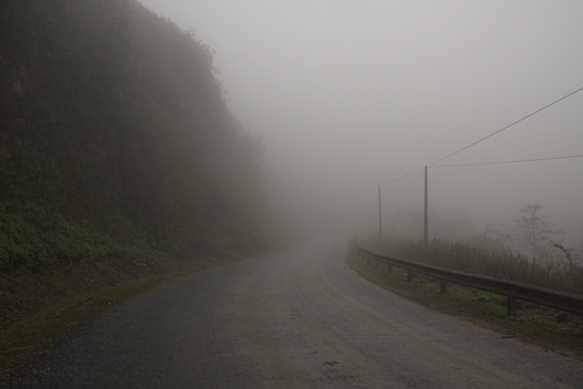
On top of Khau Pha Mountain Pass.
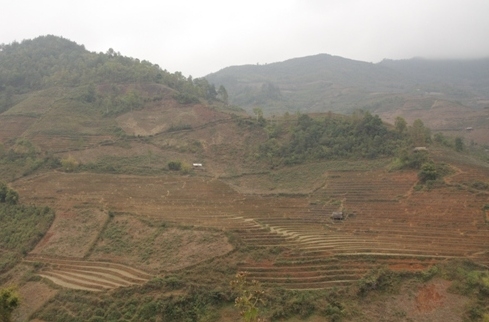
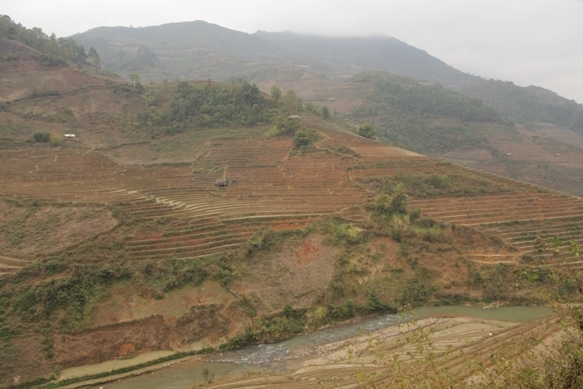
The terraced fields hasn't put on their typical green and yellow colours of cropping season.
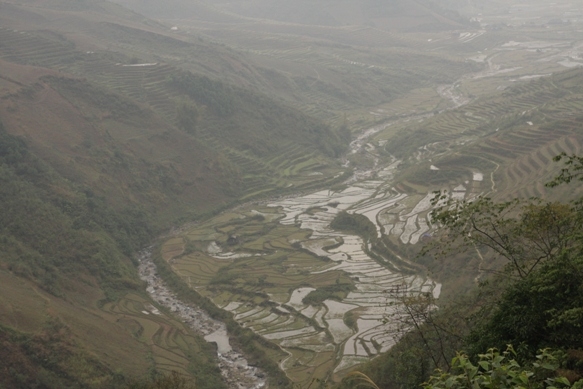
But the view was still remarkable.

Leave your comment on this story